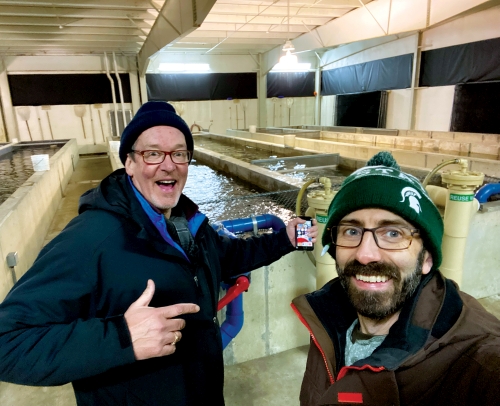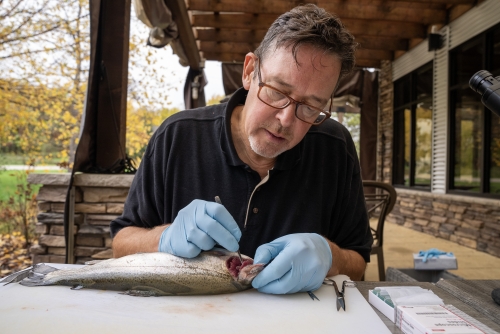As a young man, Myron Kebus would stash his fishing gear in the Free Press satchel he used for his daily paper route, strap it to his handlebars, and bike to the Detroit River.
“I was very interested in fish,” said Kebus, who grew up on the city’s east side. “I drew fish. I went fishing. I wrote about fish. I ate fish. I dreamt about fish.”
When he decided to go to veterinary school, he wanted to specialize in fish. However, few such programs existed. But Kebus persisted.
“I loved fish. I loved veterinary medicine. I wanted to combine the two. And I did it despite the advice of most people,” he recalled.
Now regarded as a worldwide expert in aquaculture, Kebus joined MSU as an assistant professor in the College of Veterinary Medicine in fall 2022. He collaborates with fish producers, researchers, and veterinarians in Michigan and beyond to strengthen fish health and train more veterinarians in aquaculture.
Kebus serves as an outreach veterinarian in the North Central United States and works with the North Central Regional Aquaculture Center (NCRAC), an organization that pairs fish farmers with researchers to support the aquaculture industry in Michigan, Illinois, Indiana, Iowa, Kansas, Minnesota, North Dakota, Ohio, and Wisconsin. Prior to joining MSU, he was director of the Fish Health Program with the Wisconsin Department of Agriculture, Trade and Consumer Protection.
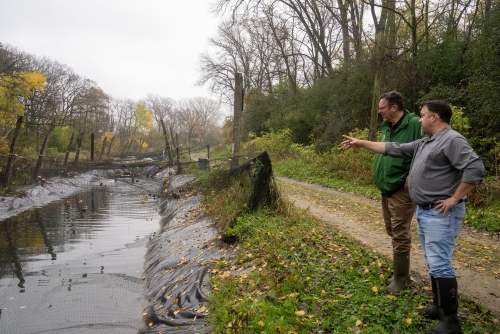
At MSU, he works closely with Thomas Loch, who is principal investigator of the Aquatic Animal Health Laboratory and is an associate professor with a dual appointment in the College of Agriculture and Natural Resources and the College of Veterinary Medicine.
What is Aquaculture?
In Michigan, aquaculture is comprised of two main sectors.
The Michigan Department of Natural Resources raises anywhere from 18 to 30 million fish, including walleye, trout, and salmon, at six hatcheries. Stocking trucks deliver them to rivers, streams, inland lakes, and the Great Lakes.
“We stock everything from small streams you could jump across to large rivers, large and small inland lakes. And we spend a lot of time traveling to take fish to the Great Lakes as well,” said Ed Eisch, assistant chief of the MDNR fisheries division.
A smaller but significant sector of aquaculture in Michigan and the region is the commercial fish industry, which raises fish primarily for food but also for bait and stocking. Worldwide more than 50 percent of the fish people eat are farm-raised. But the U.S. produces only a fraction of that number. “So we have a lot of room to grow,” Kebus said.
Challenges to Fish Health
Whether raising fish for consumption or to stock area lakes and streams, producers face a similar challenge: keeping their fish healthy.
Each species—from fathead minnows, perch, trout, and walleye, to name a few—have different environmental and nutritional requirements. Some prefer light, others don’t; some flourish on high-protein diets, others need more fat. “I try to help farmers figure out how to manage everything from water temperature to what type of food they are feeding,” Kebus said.
He works closely with fish producers, touring fish farms in Michigan and other states in the region. “Only part of the knowledge that I use is based on my veterinary training,” Kebus explained. “One of the most important components is what I’ve learned from working with farmers—seeing what works, what doesn’t work. My strategy is based on the easy premise of listening and trying to figure out what the issues are and then trying to figure out solutions.”
Loch takes a similar approach, visiting the MDNR hatcheries with his students at least once per year to observe the fish and the facility, hear from hatchery personnel about any fish health concerns, and help troubleshoot issues. “They release millions of fish each year,” he said. “Where we fit into the picture is helping them keep their fish as healthy as possible.”
If fish do get sick, MDNR personnel send samples to Loch’s lab. “My amazing team and I then determine what’s causing the ailment. In some cases, changing how fish are being raised can solve the issue. In other cases, we can recommend certain treatments that are approved for use in fish,” he said.
His team of undergraduate and graduate students, researchers, and veterinarians also certifies hatchery-raised fish to ensure they have a clean bill of health before they are released to Michigan’s waterways. “We do an exhaustive clinical examination and laboratory testing to look for a range of different viruses, bacteria, and parasites,” Loch said.
MDNR’s Eisch described his work with Loch as “one of the most successful collaborations you could ever hope to find.”
Meeting with Loch after annual facility inspections has been invaluable, Eisch said. Loch shares his observations with Eisch and the staff, offering suggestions to improve fish health and identifying biosecurity issues. “He’s really pointed out ways to improve our animal husbandry and fish health,” Eisch said.
Teamwork in the Field
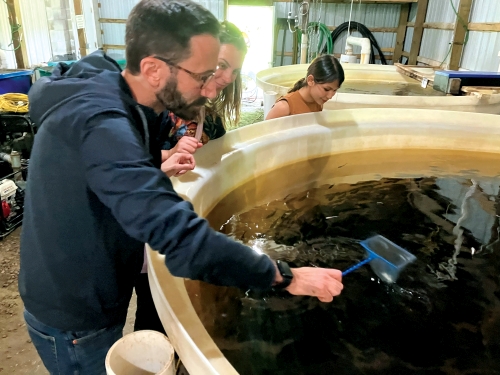
Together Kebus and Loch form a formidable team, combining Kebus’ clinical skills and Loch’s expertise as a researcher. In 2023, the two of them went on a “hatchery circuit,” visiting four hatcheries in four days. They also visit fish farms together, often bringing students with them.
Last August, for example, Kebus and Loch and their students visited Eagle Creek Fish Company in Jackson, Michigan. The company incubates eggs, then raises the young trout in artesian water-fed, 70-foot-long raceways that mimic streams.
Manager Brian Benjamin walked them through the facility, the only commercial operation in the state that hatches, grows, processes, and sells Eagle Creek rainbow trout on site. Kebus and Loch helped Benjamin troubleshoot issues, and the students received firsthand experience. “We benefited from them coming by, and they benefit because they can bring their students,” Benjamin said.
“That’s been one of the more rewarding aspects of this collaboration,” Loch said. “We’ve been working with fish farmers from the beginning. It’s not us telling them, ‘Hey, you need this.’ It’s them saying, ‘Hey can you please help us solve this?’”
For example, a fish farmer might call Kebus to report a problem. Kebus will then consult with Loch, and the two will devise a plan and arrange lab testing. Then they will meet with the farmer to go over the findings and develop a prevention plan.
Fish producers have sought Kebus and Loch’s help in combatting one of the top diseases affecting salmon and trout—bacterial cold-water disease. Loch and his lab team, particularly Nisha Shrestha (a doctoral student in the MSU Department of Fisheries and Wildlife), have been working to develop a vaccine to combat this disease.
“Where I come in is working with [Loch] to collect samples from Michigan and beyond,” Kebus said. Loch and his team are testing the samples to tease out the most problematic variants of the microbe that causes the disease. Once a vaccine is developed, Kebus and Loch plan to return to the fish farms to test it.
“It’s teamwork,” said Kebus. “I’m working in the field, and he’s working in the lab.” Loch said the collaboration with Kebus and fish producers has led to promising results. “We’re optimistic that we’re going to be able to devise a vaccine against this disease,” he said.
Training the Next Generation of Fish Veterinarians
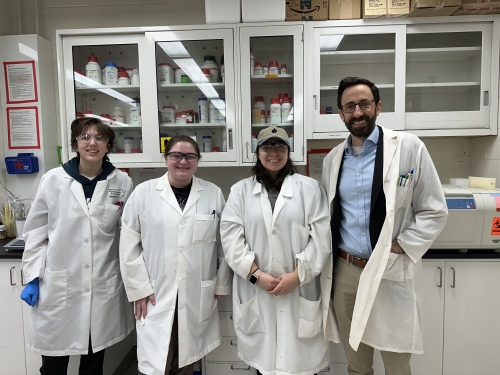
Fish producers also have identified a need for more veterinarians trained in fish health.
Last year, Kebus received a USDA grant to strengthen and bolster the fish veterinarian workforce in Michigan and the North Central region. He hosted 12 virtual meetings with experienced and aspiring fish veterinarians along with fish farmers to determine core competencies.
At a session with farmers, he asked for their input about veterinarians. “One of the comments was, ‘They can do the technical work, but they need help understanding better how fish are produced in order to really help me troubleshoot when I have a problem,” Kebus said.“
That’s why I take students to the fish farms,” Kebus said. There they can get hands-on experience with handling, feed, and other animal husbandry practices. “It’s important to learn how fish farmers are raising their fish,” he said. “Just as it’s important for an equine vet to know how shoes are put on a horse, how horses are fed.”
When Kebus and Loch entered their field, this type of training was not widely available.
“Fish and aquaculture will be key to feeding the world,” said Dalen Agnew, D.V.M., chair of the Department of Pathobiology and Diagnostic Investigation. Yet, historically, the veterinary profession “has not been as attentive to the health of aquatic animals and their environment as they really should have been,” he said.
MSU has a strong team of aquatic health researchers and offers a three-week intensive course on aquatic medicine taught by Bart Gorgoglione, D.V.M., Agnew said. Kebus’ expertise and outreach experience further strengthen the department, he said. “We needed someone to reach out to aquaculturists, veterinarians, and potential veterinarians in the field.”
Kebus and Loch are paving the way for more veterinarians to specialize in fish health. In May, they plan to offer hands-on training on basic fish farm veterinary medicine, including how to analyze fish for health problems, what to look for, and when and how to submit samples to labs like Loch’s for further testing.
Both Kebus and Loch find their work with students particularly rewarding. When Kebus tells students how he found his way to combining his love of fish and veterinary medicine despite advice to the contrary, “they light up,” he said.
Having students join them on visits to hatcheries and farms helps future veterinarians and researchers see the impact of their work on hatchery managers and fish farmers, Loch said. They realize, “I can actually use science and research to solve real-world problems,” he said.
This story originally featured on the Engaged Scholar website.
